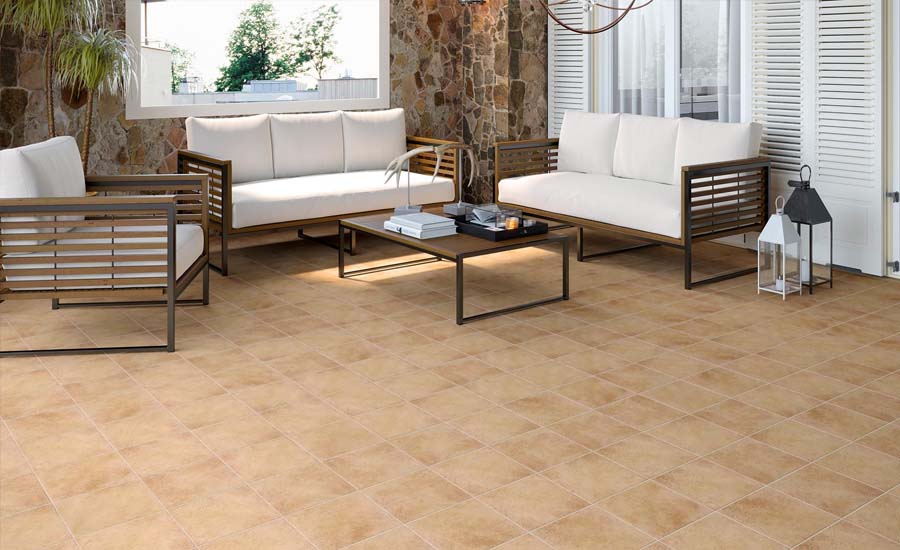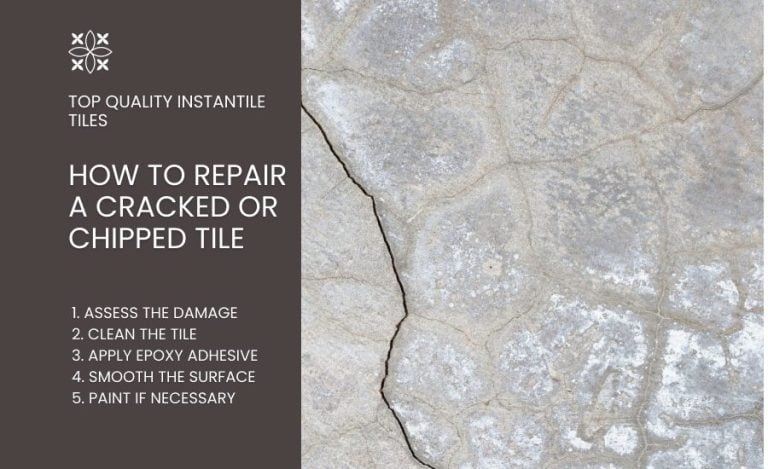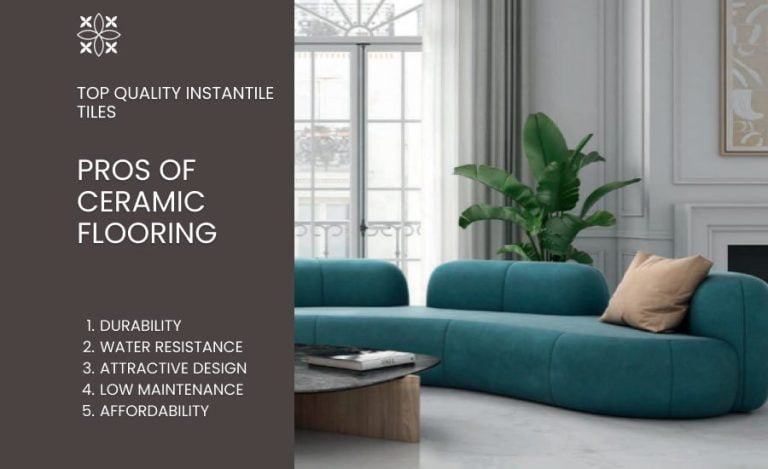Terracotta Tiles Explained: Key Takeaways
- Terracotta tiles are made from natural clay and fired at low temperatures
- They offer warm tones and rustic charm that enhance any space
- They are durable for indoor and outdoor use, and last longer with proper care
Imagine planning to have terracotta tiles in your home or office as you’ve always admired their warm, rustic charm.
Then, on a visit to a friend’s house, you notice stains on the floor and chips on the edges, and your vision of a perfect terracotta floor vanishes.
How can you keep the dream of terracotta while avoiding the risks of damage and frequent maintenance?
In this article, you will:
- Discover what makes terracotta tiles unique in texture, tone, and appeal
- Get to know the different types of terracotta tiles and how they’re used
- Understand the common challenges that come with traditional terracotta
- Find out a smarter alternative, ceramic tiles that capture the terracotta look without the drawbacks
A Closer Look at Terracotta Tiles
Terracotta tiles are natural clay tiles baked at low temperatures.
The name combines two Italian words, “terra” (earth) and “cotta” (cooked earth), explaining their warm, earthy look.
Terracotta tiles can be red, orange, or brown, depending on the type of clay used for their production.
Dating back to ancient Egypt and Rome, today, terracotta is used to create a Mediterranean or rustic atmosphere in homes and commercial spaces.
Characteristics of Terracotta Tiles
What made terracotta so popular around the world over the years ‘til today?
Rustic Feel
Terracotta tiles have a soft, rustic charm that adds character to any setting, thanks to its warm colors.
Durability
Terracotta tiles are sturdy and suitable for both indoor and outdoor use. With careful maintenance, they can last for many years.
Sustainability
A recent study found that terracotta tiles are an eco-friendly choice that supports sustainable living, making them perfect for today’s homeowners who want to create a healthier home while caring for the planet.
Types of Terracotta Tiles
Terracotta tiles come in a variety of styles and functions.
Glazed vs. Unglazed Terracotta
Glazed terracotta tiles have a protective layer that gives them a glossy look and improves their water resistance.
Unglazed tiles, on the other hand, have a natural, earthy feel. Because they don’t have protective coating, they must be sealed to prevent stains and moisture absorption.
Low-Density vs. High-Density Terracotta
Low-density terracotta tiles are lighter and more porous, making them ideal for decoration or low-traffic applications.
High-density tiles are tough enough to take the weight, so they’re perfect for spaces that get a lot of foot traffic.
Handcrafted vs. Machine-Made Terracotta
Handcrafted terracotta tiles are formed in wooden molds, air-dried, and baked in traditional kilns. As a result, you may get tiles of different sizes and textures, giving them their own beauty.
Machine-cut tiles are prepared by feeding clay into molds and presses, drying it in industrial chambers and firing it in high-temperature industrial kilns. They may go through additional treatments, such as glazing, to increase their durability and water resistance.
The machine process ensures tiles look the same and are easier to install.
Challenges With Traditional Terracotta Tiles
According to a recent survey by the Organisation for Economic Co-operation and Development, households are willing to adopt greener lifestyles.
In line with this shift, terracotta tiles have become a popular choice for their natural charm and ecological benefits.
However, despite their appeal, there are some potential challenges homeowners and designers should be aware of.
Porosity and Staining
Traditional terracotta tiles are highly porous, which means they can absorb liquids and stains easily. If they are not sealed, they may lose their earthy colors over time, especially if used in kitchens and bathrooms.
Maintenance
Terracotta tiles need regular cleaning and resealing so that they stay beautiful. This can be time-consuming and costly if they are in high-traffic or outdoor areas that require regular upkeep.
Cracking and Chipping
Terracotta tiles, while robust, can easily crack or chip when subjected to heavy furniture or intense foot traffic.
Water Sensitivity
If not sealed, the moisture absorbed by unglazed terracotta tiles can result in mold growth and warping.
These issues often prompt homeowners and real estate developers to search for alternatives to terracotta tiles for their projects.
The Alternative: Ceramic Tiles With a Terracotta Feel
Are you looking for tiles that have that warm and inviting terracotta look, but with more practical benefits?
Ceramic tiles are the ideal solution.
Durability
Ceramic tiles, unlike traditional terracotta, are more durable and will not crack or chip. They are fired at greater temperatures, making them more resistant to damage.
Water Resistance
Ceramic tiles, unlike terracotta, are non-porous, so they don’t absorb water and moisture. The non-porous texture also reduces the risk of stains, mold, and mildew.
Low Maintenance
Ceramic tiles need less time and effort to clean than terracotta, as their smooth, non-porous surface prevents dirt and grime from accumulating.
Variety
Ceramic tiles can replicate the appearance of terracotta while offering a wider range of finishes, colors, and textures, so you can choose durable tiles with a look that matches your style.
Cost-Effectiveness
Ceramic tiles are less expensive than conventional terracotta, particularly if you consider the cheaper long-term maintenance costs.
Easy Installation
Ceramic tiles are lighter and more uniform in shape and size, making them easier to install due to a lower change of lippage.
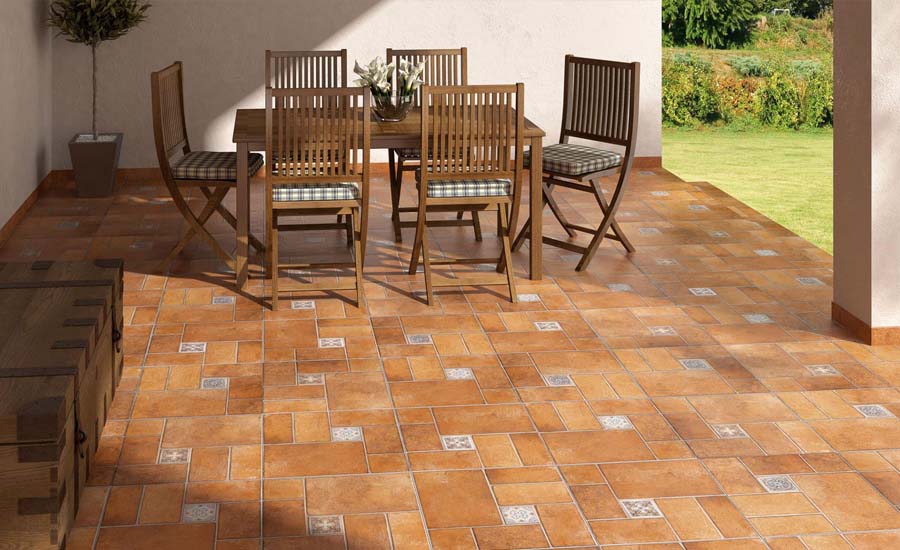
Shop Ceramic Tiles With a Terracotta Feel From Ceramista
Looking for durable ceramic tiles that capture the warmth and charm of traditional terracotta? Look no further than Ceramista!
More than just beautiful tiles, our collection features the INSTANTILE interlocking system, enabling installation up to nine times faster than conventional methods without the need for glue, grout, or specialized tools.
The result? A cleaner, faster process that reduces labor costs while delivering high-end results.
Produced using eco-friendly methods at one of Europe’s largest solar-powered facilities, these tiles combine sustainability with classic design.
Their warm reddish and cream tones authentically replicate the look of natural terracotta, adding an inviting, rustic elegance to any space.
Whether you’re designing a home or commercial space, Ceramista tiles help you achieve the character and beauty of terracotta flooring, without the maintenance challenges.
For a complete, professional finish, the collection also includes specialty pieces such as step and skirting tiles, ensuring every detail meets both aesthetic and safety standards.
Step into the warmth of tradition, with a modern twist, only at Ceramista.
For more comparisons of flooring materials read our detailed guides:
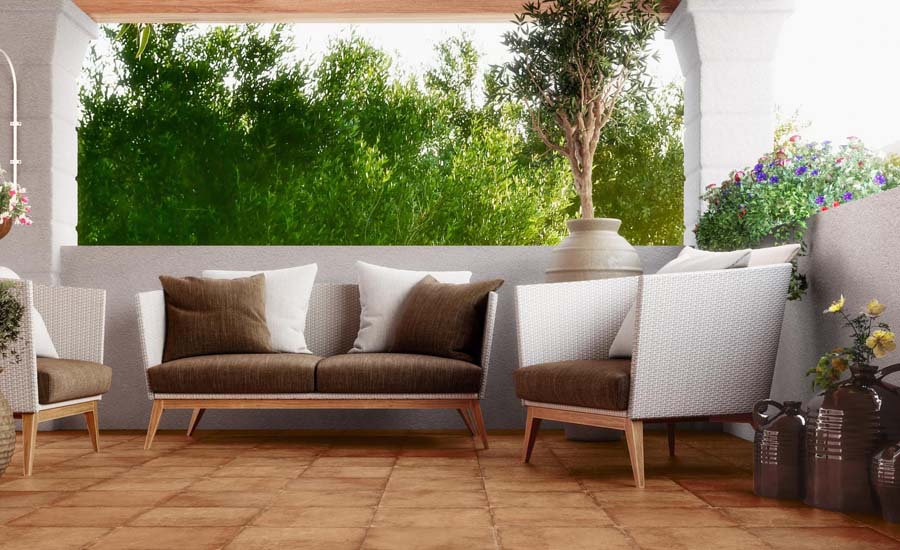
Terracotta Tiles vs. Ceramic Terracotta-Feel Tiles: FAQs
Still not sure if ceramic tiles are better than terracotta? Find more information in the section below.
Are terracotta tiles affected by climate?
Terracotta tiles are a good solution for warm, dry climates. However, if unsealed, they can cause issues when used in freezing temperatures: moisture can expand and make the tiles crack.
What is heavier: terracotta or ceramic tiles?
Terracotta tiles are heavier than ceramic or porcelain tiles because they are made from natural clay. This can make installation more difficult, and you’ll need to have a strong subfloor for proper support.
Can I use terracotta tiles in locations with high traffic?
When used in high-traffic areas, terracotta tiles may chip, crack or wear off with time. Sealing and regular maintenance can help prolong their lifespan and preserve their beauty. Consider using ceramic tiles instead to benefit from both durability and aesthetics.
Do ceramic tiles last longer than terracotta tiles?
Yes, with good care, ceramic tiles can last longer than terracotta ones — up to several decades.
Do ceramic tiles have an anti-slip layer?
Ceramic tiles can have an anti-slip surface, making them a safer option for wet areas like bathrooms or kitchens. Terracotta tiles have a naturally rough surface; however, they can become slippery when wet if not sealed properly.
Which is better for outdoor use: terracotta or ceramic tiles?
While terracotta tiles are used in outdoors spaces, bad weather can easily damage them. Consider using ceramic tiles designed specifically for outdoor use.
Our team at Ceramista can help you choose the best option for your project.
Which tiles are easier to repair: terracotta or ceramic ones?
Terracotta tiles are more fragile than ceramic ones and may require more effort to repair or replace.
Ceramic tiles are generally easier to repair. Brands like Ceramista also offer click-together options which allow replacing a damaged tile without affecting the ones around it.
Are ceramic tiles better for high-moisture environments than terracotta files?
Yes, ceramic tiles are better for high-moisture areas because their non-porous nature prevents water absorption, This, in turn, protects your settings from mold, mildew, or staining. Terracotta tiles, unless sealed properly, can absorb moisture and lead to water-related damage.
Do ceramic tiles have better insulation than terracotta tiles?
Yes, ceramic tiles have better insulation properties as their denser structure helps reduce heat transfer. Unlike ceramics, terracotta tiles are more porous, so they can absorb and release heat easily, making them less effective at insulating spaces.
